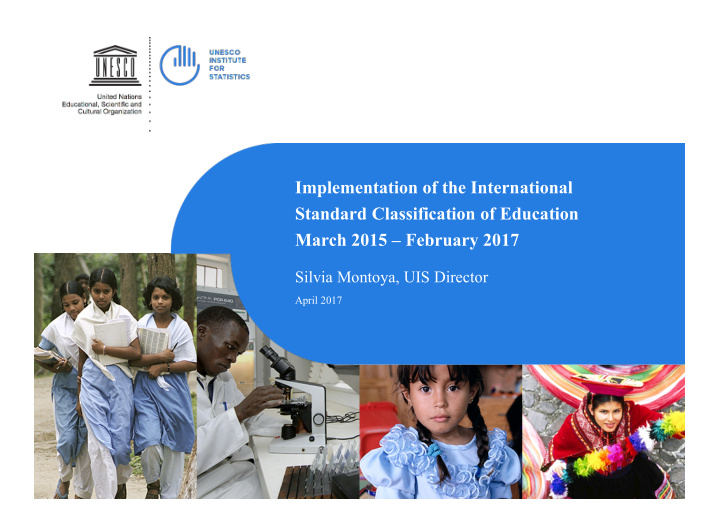



Implementation of the International Standard Classification of Education March 2015 – February 2017 Silvia Montoya, UIS Director April 2017
Implementation of the International Standard Classification of Education Background • Two major revision of the ISCED took place between 2008 and 2017 o Revision of the levels of education programmes, ISCED-P, and educational attainment, ISCED-A o Revision of fields of study, ISCED-F • The first of these, ISCED 2011, was adopted by the UNESCO General Conference in November 2011 • The second, ISCED-F 2013, was adopted in November 2013 • Papers 191 EX/20 Part V and 196 EX/17 reported on progress since the adoption of ISCED 2011 to February 2015 2
Implementation of the International Standard Classification of Education Achievements from • Implementation of ISCED 2011 in the UIS’s surveys of education and educational attainment is March 2015: complete Implementation of ISCED 2011 (ISCED-P • Fourth rounds of surveys launched in 2017 and ISCED-A) • Nearly 90% of countries are reporting education data (students, new entrants, graduates, teachers, education finance) according to ISCED-P • Around one-third of countries reporting levels of educational attainment according to ISCED-A 3
Implementation of the International Standard Classification of Education Achievements from • Implementation of ISCED-F in the UIS’s surveys of education was completed in 2016 March 2015: Implementation of • By December 2016, 100 countries (over 60% of ISCED-F 2013 those reporting data on tertiary education) had submitted fields of study data according to ISCED- F 4
Implementation of the International Standard Classification of Education Achievements from Support to countries March 2015: Support to • Operational Manual on ISCED-P and ISCED-F countries published in EN, FR and SP in 2015 Co-authored with OECD and Eurostat, the UIS’s education data collection partners • Definitions of the detailed fields of education and training (ISCED-F) providing further clarifications of the subjects covered by each field published on- line in English in 2015 • Regional and national workshops and on-site visits by UIS Regional Advisers to provide guidance in adapting to the new ISCEDs • By end of 2016, ISCED mappings for 150 countries published on-line for the benefit of data providers and data users 5
Implementation of the International Standard Classification of Education Next steps • Continued implementation and support to countries • Work on next reviews foreseen to start in o 2021 for ISCED-P and ISCED-A o 2025 for ISCED-F • Leading to possible major revisions in o 2025 for ISCED-P and ISCED-A o 2027 or 2029 for ISCED-F 6
Implementation of the International Standard Classification of Education
Implementation of the International Standard Classification of Education The Executive Board is The Executive Board, invited to adopt the • Having examined document 201 EX/17, following decision (201 • Recalling 36 C/Resolution 11 and 37 C/Resolution EX/17, para 7) 10 ion the International Standard Classification of Education (ISCED), • Takes note of the work undertaken on the implementation of the 2011 and 2013 revisions of ISCED and ISCED-F respectively between March 2015 and January 2017, • Invites the Director General to submit a report to the General Conference at its 39 th session on the work undertaken since the adoption of the 2011 and 2013 revisions of ISCED and ISCED-F 2013 respectively. 8
Implementation of ISCED Silvia Montoya, UIS Director uis.director@unesco.org Learn more: http://uis.unesco.org/ @UNESCOstat
Recommend
More recommend